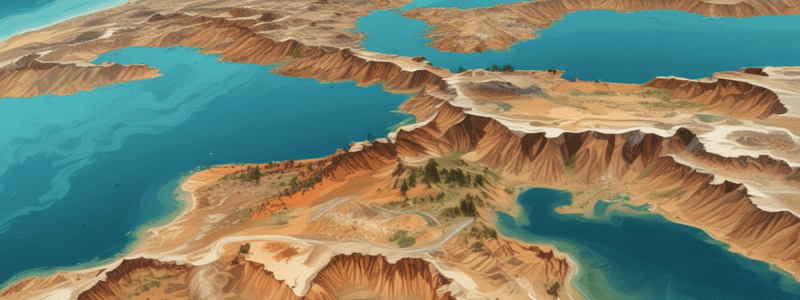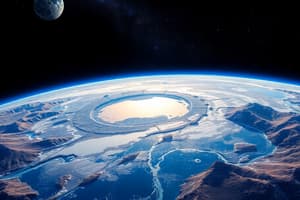Podcast
Questions and Answers
The revisit time of a satellite is solely dependent on its orbital period.
The revisit time of a satellite is solely dependent on its orbital period.
False (B)
A smaller IFOV always results in a better signal-to-noise ratio.
A smaller IFOV always results in a better signal-to-noise ratio.
False (B)
The repeat cycle of a satellite is affected by the location of the target.
The repeat cycle of a satellite is affected by the location of the target.
True (A)
A higher spatial resolution is always desirable in multispectral scanner systems.
A higher spatial resolution is always desirable in multispectral scanner systems.
The Field of View (FOV) of a sensor is the smallest detail that can be detected or seen in an instant.
The Field of View (FOV) of a sensor is the smallest detail that can be detected or seen in an instant.
Landsat 9 replaces Landsat 8 in orbit, taking its place 8 days out of phase.
Landsat 9 replaces Landsat 8 in orbit, taking its place 8 days out of phase.
The combined Landsat 8 and Landsat 9 revisit time for data collection is every 16 days.
The combined Landsat 8 and Landsat 9 revisit time for data collection is every 16 days.
The Landsat 9 OLI-2 sensor has a repeat cycle of 16 days.
The Landsat 9 OLI-2 sensor has a repeat cycle of 16 days.
The Landsat 9 TIRS-2 sensor has a field of view of 30 meters.
The Landsat 9 TIRS-2 sensor has a field of view of 30 meters.
Landsat 8 and Landsat 9 have a ground track that is 1 day out of phase with each other.
Landsat 8 and Landsat 9 have a ground track that is 1 day out of phase with each other.
A longer orbital period of a satellite results in a shorter revisit time.
A longer orbital period of a satellite results in a shorter revisit time.
The ground track of a satellite is the path it follows on the Earth's surface during a single pass.
The ground track of a satellite is the path it follows on the Earth's surface during a single pass.
The repeat cycle of a satellite is solely dependent on its orbital period.
The repeat cycle of a satellite is solely dependent on its orbital period.
A smaller field of view always results in a higher spatial resolution.
A smaller field of view always results in a higher spatial resolution.
The revisit time of a satellite is the same as its repeat cycle.
The revisit time of a satellite is the same as its repeat cycle.
The time taken to complete one revolution of the orbit is called the repeat cycle of the satellite.
The time taken to complete one revolution of the orbit is called the repeat cycle of the satellite.
The ground track of a satellite refers to the path it follows around the Earth.
The ground track of a satellite refers to the path it follows around the Earth.
A satellite's repeat cycle is the time interval in which the nadir point of the satellite passes over the same point on the Earth's surface for a second time.
A satellite's repeat cycle is the time interval in which the nadir point of the satellite passes over the same point on the Earth's surface for a second time.
The field of view of a satellite determines its swath width.
The field of view of a satellite determines its swath width.
The revisit time of a satellite is the time taken to complete one revolution of the orbit.
The revisit time of a satellite is the time taken to complete one revolution of the orbit.
The repeat cycle of a satellite is solely dependent on its orbital period.
The repeat cycle of a satellite is solely dependent on its orbital period.
A higher spatial resolution is always desirable in multispectral scanner systems, but it is not always achievable due to the trade-off with the sensor's field of view.
A higher spatial resolution is always desirable in multispectral scanner systems, but it is not always achievable due to the trade-off with the sensor's field of view.
The ground track of a satellite is the path it follows on the Earth's surface, which is dependent on its orbital period and inclination.
The ground track of a satellite is the path it follows on the Earth's surface, which is dependent on its orbital period and inclination.
The revisit time of a satellite is the time it takes for the satellite to repeat its ground track over the same location.
The revisit time of a satellite is the time it takes for the satellite to repeat its ground track over the same location.
The field of view of a sensor is the largest detail that can be detected or seen in an instant.
The field of view of a sensor is the largest detail that can be detected or seen in an instant.
The repeat cycle of a satellite is solely dependent on its orbital period and location of the target.
The repeat cycle of a satellite is solely dependent on its orbital period and location of the target.
A higher spatial resolution is always desirable in multispectral scanner systems because it results in a better signal-to-noise ratio.
A higher spatial resolution is always desirable in multispectral scanner systems because it results in a better signal-to-noise ratio.
The ground track of a satellite is the path it follows on the Earth's surface during a single pass and is affected by its orbital period.
The ground track of a satellite is the path it follows on the Earth's surface during a single pass and is affected by its orbital period.
A smaller Field of View (FOV) of a sensor always results in a higher spatial resolution.
A smaller Field of View (FOV) of a sensor always results in a higher spatial resolution.
The revisit time of a satellite is solely dependent on its orbital period and is the same as its repeat cycle.
The revisit time of a satellite is solely dependent on its orbital period and is the same as its repeat cycle.
The combined Landsat 8 and Landsat 9 revisit time for data collection is every 8 days.
The combined Landsat 8 and Landsat 9 revisit time for data collection is every 8 days.
The Field of View (FOV) of a sensor is the smallest detail that can be detected or seen in an instant, and it is directly related to its spatial resolution.
The Field of View (FOV) of a sensor is the smallest detail that can be detected or seen in an instant, and it is directly related to its spatial resolution.
A longer orbital period of a satellite results in a shorter revisit time and a longer repeat cycle.
A longer orbital period of a satellite results in a shorter revisit time and a longer repeat cycle.
Landsat 9 replaces Landsat 8 in orbit, taking its place 16 days out of phase.
Landsat 9 replaces Landsat 8 in orbit, taking its place 16 days out of phase.
The Tier 1 data is immediately provided after acquisition in less than 12 hours.
The Tier 1 data is immediately provided after acquisition in less than 12 hours.
The repeat cycle of a satellite is solely dependent on its orbital period.
The repeat cycle of a satellite is solely dependent on its orbital period.
A smaller Field of View (FOV) always results in a better signal-to-noise ratio.
A smaller Field of View (FOV) always results in a better signal-to-noise ratio.
High spatial resolution is always desirable in multispectral scanner systems.
High spatial resolution is always desirable in multispectral scanner systems.
The ground track of a satellite is affected by its revisit time.
The ground track of a satellite is affected by its revisit time.
The orbital period of a satellite is directly proportional to its repeat cycle.
The orbital period of a satellite is directly proportional to its repeat cycle.
Flashcards are hidden until you start studying




